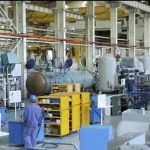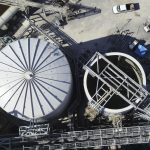Titan
Sized
Triumphs
NESTEC: A Band of Engineers Handles Sizeable Chores
NESTEC employs about dozen people, but don’t think of the company as small. It’s big enough to solve emissions challenges for some of the largest manufacturers in the world.
The Pen Argyl, Pa.-based company, which bills itself as an OEM provider of thermal oxidation systems and air pollution control, builds new equipment and keeps older equipment operating, says Jim Nester, NESTEC president. Most of its employees are degreed environmentally focused engineers with at least 25 years of industry experience, he notes.
For clients seeking new equipment, the company builds regenerative, catalytic, straight thermal oxidizer systems, Nester says. To keep established equipment online, the company’s service and aftermarket group performs annual inspections, energy audits and upgrades, and it applies newer technology to older equipment, he maintains.
NESTEC’s seasoned engineers are positioned to extend the life of equipment that’s no longer supported by the companies that made it, Nester notes. What’s more, NESTEC stocks spare parts for that equipment, he says.
The company’s engineers use a warehouse and partial-assembly facility at the company’s headquarters to pull together the necessary parts and assemble equipment before shipping it to customers, notes Rod Pennington, the company’s vice president of special projects.
NESTEC’s seasoned engineers are positioned to extend the life of equipment that’s no longer supported by the companies that made it.
In its eChem Expo seminar and exhibits, NESTEC plans to present information on using thermal oxidation instead of scrubbers to control emissions, Nester says. “One area is seeing the viability and applicability of the various types of thermal oxidizers on those sources,” he says.
“We would want to meet with plant managers, plant engineers and maintenance engineers to try to get a good handle on process conditions,” Nester says of eChem Expo. That way NESTEC can “assist with matching up our technology with where it can be best applied.”
In stakeholder interviews conducted by eChem Expo in the months leading up to the conference and exhibits, plant management and operations people reported that scrubbers weren’t equal to the challenges at their facilities and that they wanted to look at oxidation systems, including mobile systems.
“The thermal oxidizer will get a higher removal efficiency, and there’s not any secondary treatment of the water for the blowdown from the scrubber,” Nester says. “When you’re oxidizing the chemistry, you’re going to do it at a very high rate – 98 or 99 percent effectiveness.” A scrubber may require expensive chemistry to scrub an organic compound, he maintains.
On the other hand, a thermal oxidizer provides a cleaner, simpler and more effective way to control emissions, and that can allow plants to expand operations while remaining below emissions caps, Nester says.
Mobility was an issue raised in the eChem Expo stakeholder interviews. In response, Nester notes that in regenerative technology even a small system can weigh tens of thousands of pounds. Mobility would require a direct-fired oxidizer or a flare manufactured to move from source to source, he says. “Typically, our systems are stationary,” he adds.
“The plant’s basically turning an air emission into a saleable product.”
Jim Nester
referring to conversion of chlorine gas to a food-grade hydrochloric acid
NESTEC developed equipment that produces hydrochloric acid from oxidation at a rate of 10,000 pounds/hour of chlorine gas.
In its eChem Expo seminar,
NESTEC plans to emphasize regenerative thermal oxidizers, or RTOs, says Pennington. Plants usually purchase systems that fall into that category because they save energy, he notes. The company’s seminar will also cover ways of using recuperative and catalytic systems with concentrators, he adds.
Much of the technology NESTEC employs is well-established, but the company develops and integrates new features, Nester says. When particulates pose a problem, for example, new online cleaning techniques can handle them, he maintains. In another example, the company has improved controls to ensure thermal balance, he says. Such improvements lower operating costs and make equipment work better, he maintains.
In another relatively new example, the online bake out that NESTEC has introduced enables plants to keep operating without downtime, Pennington says. Depending upon the process, the feature could keep the plant operating at full flow, he says. It also eliminates organic buildup, he continues, noting that in the past plants shut down equipment based on production requirements and could accumulate a lot of organic material in the equipment. When they brought down the oxidizer, they could find themselves with runaway fires because of an excess of combustibles built up in the equipment. “This feature allows us to clean and bake it out based on the needs of the oxidizer, not on the availability of the process,” he contends.
The online bake out that NESTEC has introduced enables plants to keep operating without downtime.
The controls package that NESTEC offers helps plants integrate data digitally to complete their EPA reporting and accomplish other tasks, Nester says. “We’ve kept pace with the modernization of the control side as well,” he reports.
NESTEC prides itself on its ability to integrate its technology with other systems, Nester says. “So for instance, if there’s any type of upstream particulate control that may be required, or any downstream acid gas scrubbing, or secondary heat recovery or using energy from the RTO to create steam with a heat-recovery steam generator – we’ve done all these types of projects,” he asserts.
NESTEC also offers control systems that tie into systems operating in the field and enable NESTEC to view the information remotely, says Pennington. NESTEC can also use that technology itself to respond quickly when problems arise for its customers, he notes.
Projects that are the first of their kind aren’t uncommon for NESTEC. In one example, the company brought in outside experts and partnered with a company that does downstream acid concentration to use methane as a feed source to convert chlorine gas to a food-grade hydrochloric acid. “They’re basically turning an air emission into a saleable product,” he maintains.
When a plant shuts down, NESTEC sometimes buys and repurposes used environmental equipment. “When we find older systems that still have life left in them, we will acquire them,” Nester says, “to help some of the other industries that maybe don’t have as much money to spend on something new.”
The controls package that NESTEC offers helps plants integrate data digitally to complete their EPA reporting and accomplish other tasks.
Nester started NESTEC in 1999 but the company took its present form in 2005 when a group of industry veterans came together and began growing the enterprise. Most are mechanical engineers even though they handle a lot of chemistry on the job. Combined, the principals have racked up more than 300 years of experience at providing air pollution control and abatement for a wide range of industries, including chemical processing plants.
Six employees work at the headquarters in Pan Argyl and three are based in New Jersey. There’s one each in Florida, Illinois and Wisconsin. Manufacturers’ reps around the country support the company’s sales efforts.
The company’s field staff meet safety standards and are trained to deal with confined space, lockout/tagout, fall protection, asbestos, hazard communication and all areas of training for Hazardous Waste Operations and Emergency Response (HAZWOPER).
When the need arises on a particular project, the company engages outside expertise in whatever engineering discipline’s needed, Pennington says. That willingness to reach outside the company gives NESTEC the ability to complete unique projects, he notes.





